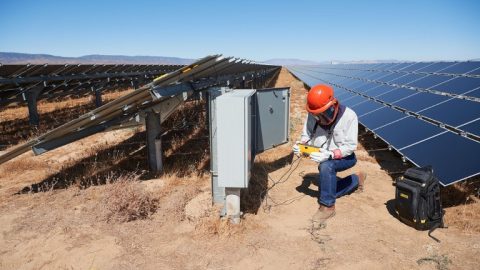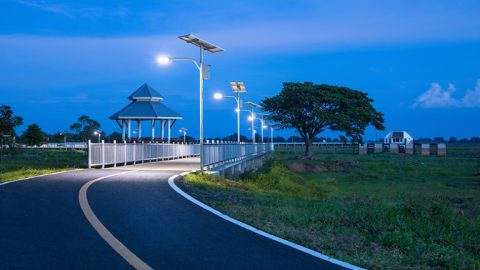Solar power plants play a big role in making clean and sustainable energy. They use advanced technology and are easy to maintain to keep making energy all the time. One important thing for maintenance is the Fire Protection System. It’s like a safety guard for the equipment and people working there. This article talks about how we can take care of the Fire Protection System in solar power plants to prevent any major problems.
Solar power is a type of energy that comes from the sun and is used more and more all over the world. It’s becoming the fastest-growing way to generate electricity, according to the Solar Electric Power Association.
There are two main ways to turn sunlight into electricity: photovoltaic (PV) and concentrated solar power (CSP)/solar thermal power. While solar energy is good for the environment, it can still cause fires.
Photovoltaic (PV):
- A PV cell (also called a solar cell) turns light into electricity. Each cell makes about 1-2 watts of energy.
- The electricity made by the cells is in a form called direct current (DC). But we need to change it to a different type called alternating current (AC) to use it. This change is done by devices called inverters.
- PV cells and inverters are at risk of being hit by lightning, which could start a fire. There’s also a danger of getting shocked while fighting a fire because it’s hard to turn off PV cells. So, it’s important to have fire protection (like detectors and sprinklers) in the places where PV power is made.
Concentrated Solar/Solar Thermal (CSP):
- CSP uses lenses, mirrors, or other tools to focus sunlight into a strong beam. This beam is then used to create electricity in a regular power plant.
- Different CSP technologies exist, like Concentrating Linear Fresnel Reflector, Stirling Dish, Linear Parabolic Reflector/Parabolic Troughs, Solar Dish, and Solar Power Tower.
- The heat created in CSP can be risky because it uses special fluids. These fluids can catch fire, and the risk is there in both the solar fields and the power plant. So, fire detectors and sprinklers are crucial for safety.
For safety, we can use:
- Early fire detection: Warns us early if there’s a risk of fire.
- Flame-sensing fire detectors: Quickly notice when a fire starts and alert us.
- Smoke fire detectors: Detect smoldering fires in different places.
- Wet pipe fire sprinklers: Used in various buildings to put out fires.
- Deluge fire sprinklers: In outdoor areas with special fluids, these sprinklers can quickly control or put out fires.
Significance of Fire Protection in Solar Power Plants
The Fire Protection System in solar power plants is super important to keep things safe. You see, solar power plants have lots of electrical stuff like inverters, transformers, and panels that can pose fire risks. So, it’s crucial to understand why fires might happen in these solar plants before figuring out how to stop them. Let’s examine why a robust fire protection system is vital:
Keep your solar plant safe with reliable fire detection solutions. Book A Demo today to improve your fire protection system!
Potential Causes of Fire in Solar Plants
Although solar power plants provide clean and sustainable energy, solar power plants pose some fire hazards as well. Understanding the reasons behind potential fires is important for implementing effective preventive measures. Various factors, such as electrical faults, overheating, human faults, and environmental conditions, can contribute to fire incidents in solar power plants. Considering these factors before developing a Fire Protection System is necessary to ensure personnel and assets safety.
Early Fire Detection and Suppression
Fires can start due to various factors, such as electrical faults, overheating, or environmental conditions. The Fire Protection System uses smoke detectors, heat sensors, and fire suppression equipment, ensuring early detection and rapid suppression of fires. Their inspection frequency usually depends upon the risk assessment, but here is a general formula that can be helpful in routine inspections.
Inspection Frequency = Risk Assessment Score / Maximum Possible Score x 100
- Asset Protection
Solar power plants comprise high-value assets, including photovoltaic panels and electrical infrastructure. A well-maintained Fire Protection System safeguards these assets from potential fire-related damage, minimizing costly downtime and repairs.
Personnel Safety
Ensuring the safety of personnel working at solar power plants is a primary concern. Ensuring the personal safety of individuals working at solar power plants and maintaining an effective Fire Protection System is also important. Personal Safety measures include guidelines for plant workers and first responders during emergencies. These tips may include evacuation procedures, proper use of personal protective equipment (PPE), fire alarms, and emergency response protocols. Considering individual safety measures enhances the overall effectiveness of the Fire Protection System and contributes to a secure working environment in solar power plants.
Inspection Compliance Rate (IR) is a term used to trace the inspection history of fire extinguishers for the safety of people working there and for the safety of expensive equipment.
IR = NInsp / NTotal x 100
Where,
NInsp = Fire extinguishers inspected
NTotal = Total fire extinguishers installed at solar plant
Components of a Fire Protection System
A typical Fire Protection System in a solar plant consists of several key components, each requiring regular preventive maintenance to ensure reliable operation. Let’s delve into these components along with relevant technical aspects:
1. Smoke Detectors and Heat Sensors
The performance of smoke detectors and heat sensors is evaluated through regular testing, including sensitivity checks and response time measurements. Here are some preventive maintenance checks that must be followed.
| Component | Inspection Frequency | Test Parameters | Acceptance Criteria |
| Smoke Detectors | Monthly | Sensitivity, Response Time | Within Limits |
| Heat Sensors | Quarterly | Response Time | Within Limits |
Smoke Detectors Sensitivity
Smoke detector sensitivity can be calculated easily using the following;
Sensitivity (%) = Tested Obscuration / Expected Obscuration x 100
2. Fire Alarm Panel
The Fire Alarm Panel is the central control unit of the system. It is tested to ensure its ability to receive sensor signals, process data, and trigger alarms and suppression mechanisms.
| Component | Inspection Frequency | Test Parameters | Acceptance Criteria |
| Fire Alarm panel | Quarterly | Signal Reception, Alarm Activation | Alarms proper Functioning |
3. Fire Suppression Equipment (Sprinklers/Extinguishers)
Fire suppression equipment, including sprinklers and extinguishers, should be visually inspected for damage, and pressure tests should be performed to ensure they are pressurized and ready for use.
| Component | Inspection Frequency | Test Parameters | Acceptance Criteria |
| Sprinkles | Quarterly | Visual Inspection, Pressure Test | No Visible Damage, Pressurized Equipment |
| Heat Sensors | Annually | Visual Inspection | No Visible Damage/ Signs of Leakage |
Effectiveness of Fire Suppression System
This tells about how much we can rely on this fire suppression system depending upon its efficiency. Here is a simple formula to know about its condition.
Effectiveness (%) = Number of Successful Suppressions / Total Fires Occurred x 100
Conclusion
In summary, having a strong fire protection system in solar power plants is super important. It helps keep valuable stuff safe and makes sure the people working there stay protected. Following a preventive maintenance plan, like the one mentioned earlier, is a big deal. It keeps the system working well and helps prevent fires. If solar power plants stick to these maintenance steps, they can keep making clean and sustainable energy for the future.
Click on the below download link for the Sample of Fire Protection Maintenance File.


































